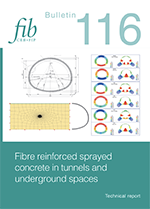Fibre reinforced sprayed concrete in tunnels and underground spaces
fib BULLETIN NO. 116
Title: Fibre reinforced sprayed concrete in tunnels and underground spaces
Technical report
Year: 2025
Pages: 67
Format approx. DIN A4 (210x297 mm)
ISBN: 978-2-88394-193-9
Abstract:
This document aims to support Designers, Contractors and Clients with guidance for the use of structural fibre reinforced concrete, known as FRC, in tunnels and underground spaces, constructed using sprayed concrete lining methods (even if some of the presented principles can also be adopted for FRC cast in situ). These construction methods include the New Austrian Tunnelling Method (NATM), Sprayed Concrete Lining Method (SCL) or Sequential Excavation Method (SEM), and whilst the design principles for these three approaches have some similarities, they are underpinned by different design philosophies. For the structural design of the lining itself however, these differences are not important.
The term “structural fibre” may relate to a range of materials. The performance of the fibre in the short and long-term (including strain and thermal compatibility with the host material matrix) shall be clearly defined by the Designer and shall be verified as part of the pre-construction test programme.
Fibre-Reinforced Concrete (FRC) is a composite material characterised by a cement matrix and discrete discontinuous fibres. The matrix is made of either concrete or mortar. Fibres can be manufactured of steel, polymers, carbon, glass or natural materials of different types and different sizes of fibres can also be used. These are commonly known as hybrid fibre reinforced concrete. Fi bre reinforced sprayed concrete may also be combined with bar or mesh reinforcement systems (Steel or GFRP for instance) but significant care must be taken in the detailing and spraying of such systems to ensure proper encapsulation of the bar reinforcement.
The document is intended to complement the fib Model Code 2010 (MC 2010) which presents a section on the design of fibre reinforced concrete, with the Model Code 2010 being considered as the reference basis for the design of sprayed fibre reinforced concrete linings.
It applies to tunnels constructed in both soft ground and rock and is relevant to temporary and permanent linings and primary and secondary linings. Whilst it is envisaged that wet sprayed methods of construction will be primarily used, dry sprayed methods are not prohibited, but these will be governed by the same performance criteria as wet sprayed concrete.
The document is mainly focused on the permanent FRC used as the primary lining, but the design philosophy can also be applied for FRC secondary lining.
Guidance given in this document is based on the experience of the authors from several sprayed concrete tunnelling projects which have used structural fibre reinforced concrete and is intended to support the implementation of the design of steel fibre reinforced linings. The guidance is however not intended to be prescriptive, and the designers should use appropriate skill and judgment in the design, considering the particular requirements and conditions of the project under consideration.
Download the copyright page (= list of authors) as a PDF file.
Download the table of contents as a PDF file.



